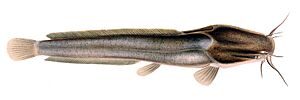Clarias gariepinus facts for kids
Quick facts for kids Clarias gariepinus |
|
|---|---|
 |
|
| Conservation status | |
| Scientific classification | |
| Synonyms | |
|
The African sharptooth catfish, also known as Clarias gariepinus, is a type of catfish. It belongs to the family Clariidae, which are special because they can breathe air. This ability helps them survive in many different places.
Contents
Where Do African Sharptooth Catfish Live?
These catfish are found all over Africa and the Middle East. They love freshwater places like lakes, rivers, and swamps. You can also find them in places made by humans. This includes oxidation ponds and even city sewage systems.
In the early 1980s, people started to introduce the African sharptooth catfish to other parts of the world. This was mainly for aquaculture, which is like farming fish. Because of this, you can now find them far from their natural home. They live in countries like Brazil, Vietnam, Indonesia, and India. In Indonesia, where other Clarias species live, this catfish is called lele dumbo.
What Does the African Sharptooth Catfish Look Like?


The African sharptooth catfish is a big fish with a body like an eel. Its back is usually dark gray or black, and its belly is white. These fish can grow quite large. They are known to be one of the biggest catfish in Africa.
Most adult African sharptooth catfish are about 1 to 1.5 meters (3 to 5 feet) long. The longest one ever found was 1.7 meters (5.6 feet) long. It can weigh up to 60 kilograms (132 pounds)! They have thin bodies and flat, bony heads. Their heads are flatter than those of other catfish types. They also have wide mouths with four pairs of barbels, which are like whiskers. These barbels help them find food.
A special feature of these fish is their large extra breathing organs. These organs are made from changed gill arches. They help the catfish breathe air. Only their pectoral fins have spines.
How Do African Sharptooth Catfish Behave?
Like many catfish, the African sharptooth catfish is active at night. It eats both living and dead animals. Its diet includes insects, tiny water creatures called plankton, snails, crabs, shrimp, and other small animals without backbones. They also eat birds, reptiles, amphibians, small mammals, and other fish. Sometimes, they even eat eggs. They also eat plants, like fruit and seeds.
Because they have a wide mouth, they can swallow pretty big prey whole. They have even been seen eating large waterbirds like the common moorhen. These catfish are also amazing because they can crawl on dry ground. This helps them escape from pools that are drying up. They can also survive in shallow mud for a long time, especially between rainy seasons.
African catfish can make loud croaking sounds. These sounds are a bit like the voice of a crow.
Reproduction and Life Cycle
Spawning, which is when fish lay eggs, usually happens at night. It takes place in shallow, flooded areas of rivers, lakes, and streams. Before mating, male catfish can be quite aggressive with each other.
Mating happens in shallow water between one male and one female. The male wraps his body in a U-shape around the female's head. They stay like this for a few seconds. Then, the male releases his milt (sperm) and the female releases her eggs. The female then wiggles her tail strongly to spread the eggs over a wide area. After mating, the pair usually rests for a short time before mating again.
The parents do not take care of their young after the eggs are laid. However, they do choose a good spot for the eggs to be safe. The eggs and young fish develop very quickly. The baby fish can swim within 48 to 72 hours after fertilization.
Why Are They Farmed?
People started raising African sharptooth catfish in Central and Western Africa in the early 1970s. They realized this fish was great for aquaculture (fish farming) for many reasons:
- They grow fast and can eat many different farm leftovers.
- They can handle poor water quality.
- They can be raised in crowded spaces, which means farmers can get a lot of fish from a small area.
- In most countries, they sell for more money than tilapia. This is because they can be sold alive at the market.
- They grow up and can reproduce fairly easily in captivity.
- They can handle tough conditions on fish farms.
Hybrid Catfish
The Clarias gariepinus can be easily bred with another fish called Heterobranchus longifillis. This creates a new type of fish called a Hetero-clarias hybrid. This hybrid has some good points compared to the African sharptooth catfish:
- It cannot reproduce, so it doesn't use energy on making babies.
- It has white meat, which many customers prefer.
However, the Hetero-clarias hybrid has a big problem: it gets stressed easily.
There have also been stories about other hybrids. For example, one with C. fuscus was supposedly sent to Indonesia from Taiwan. It was called Lele Dumbo and was said to produce much more fish than the local C. batrachus. However, it's hard to prove if this hybrid really exists.



